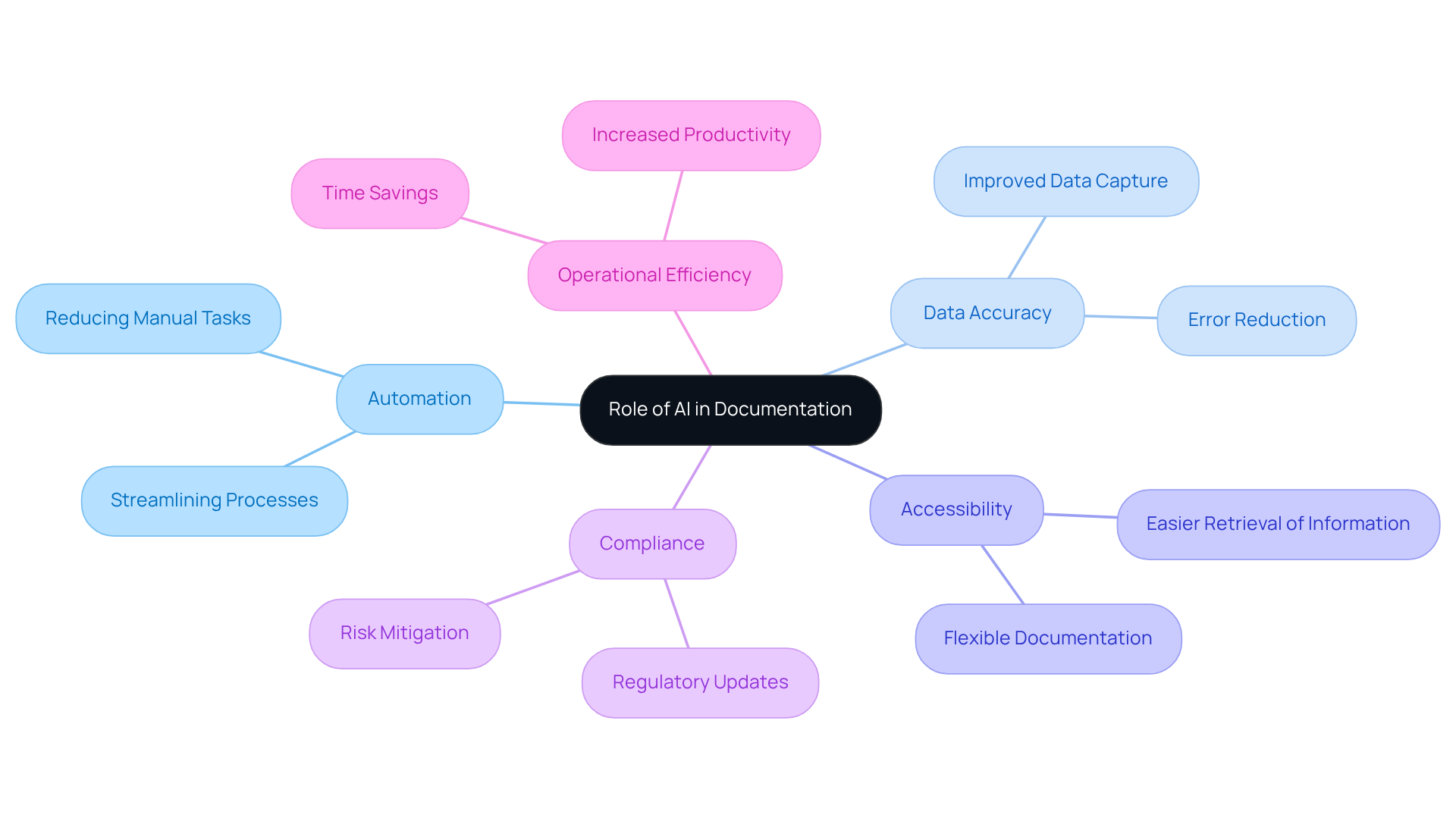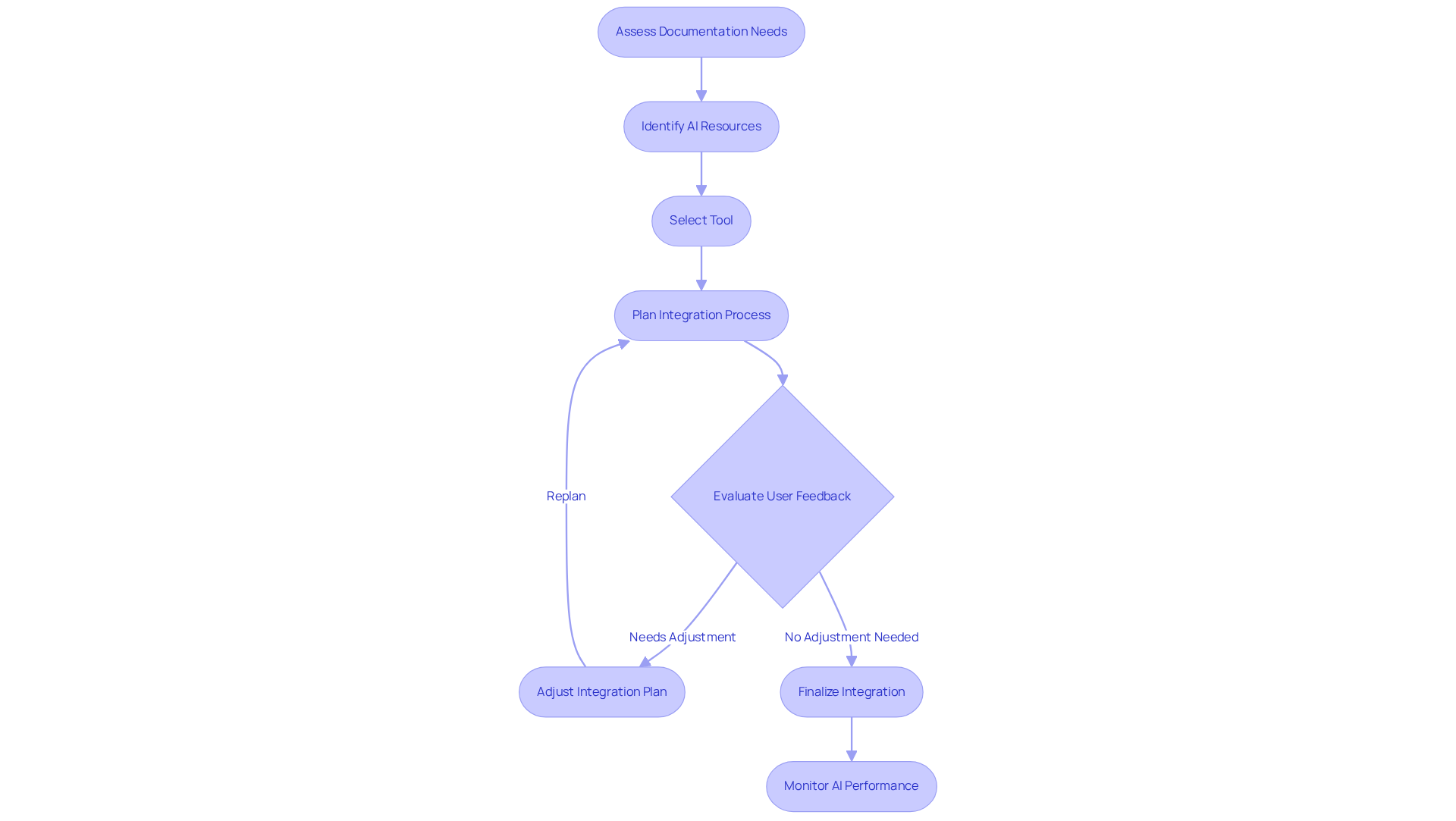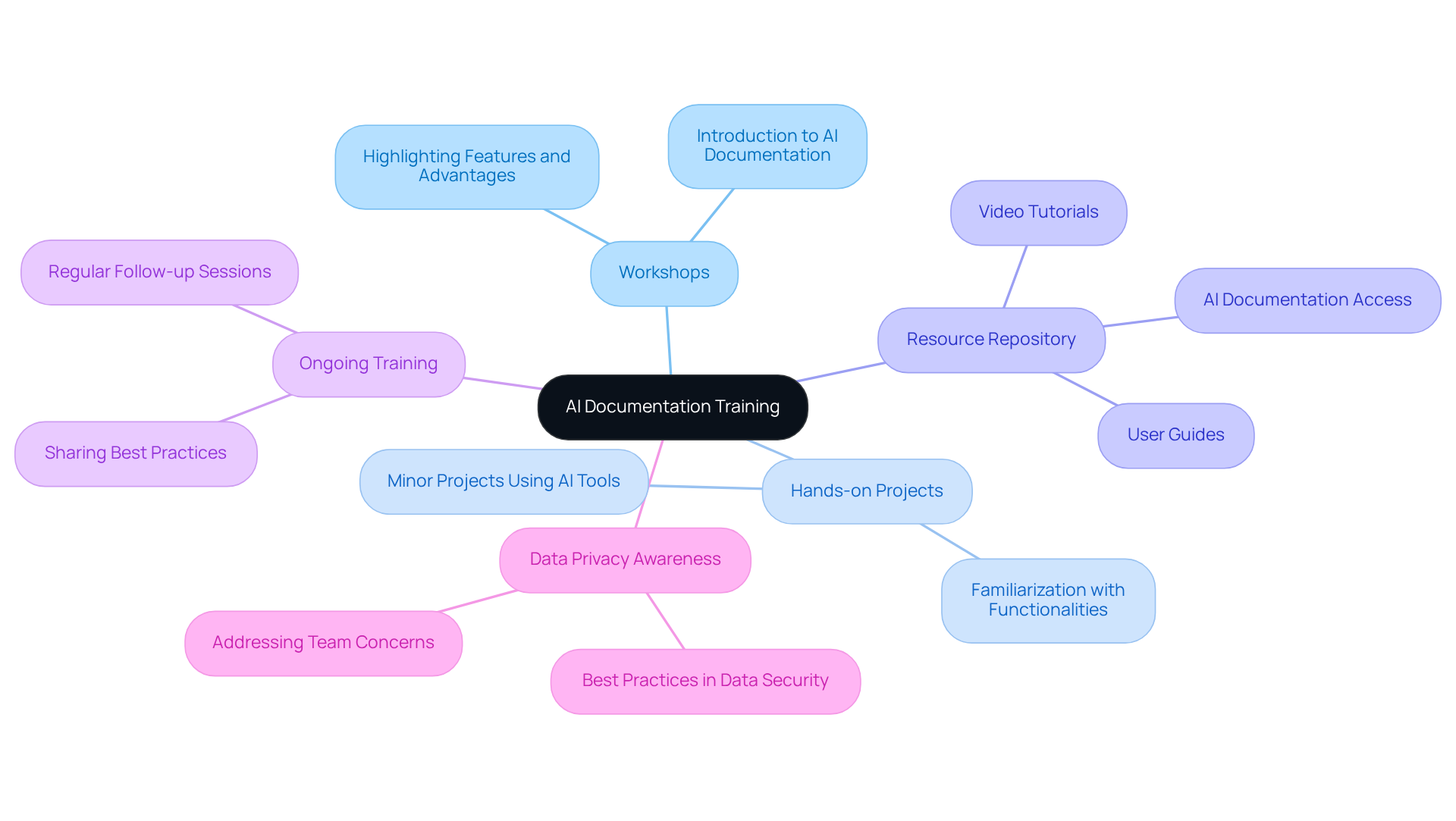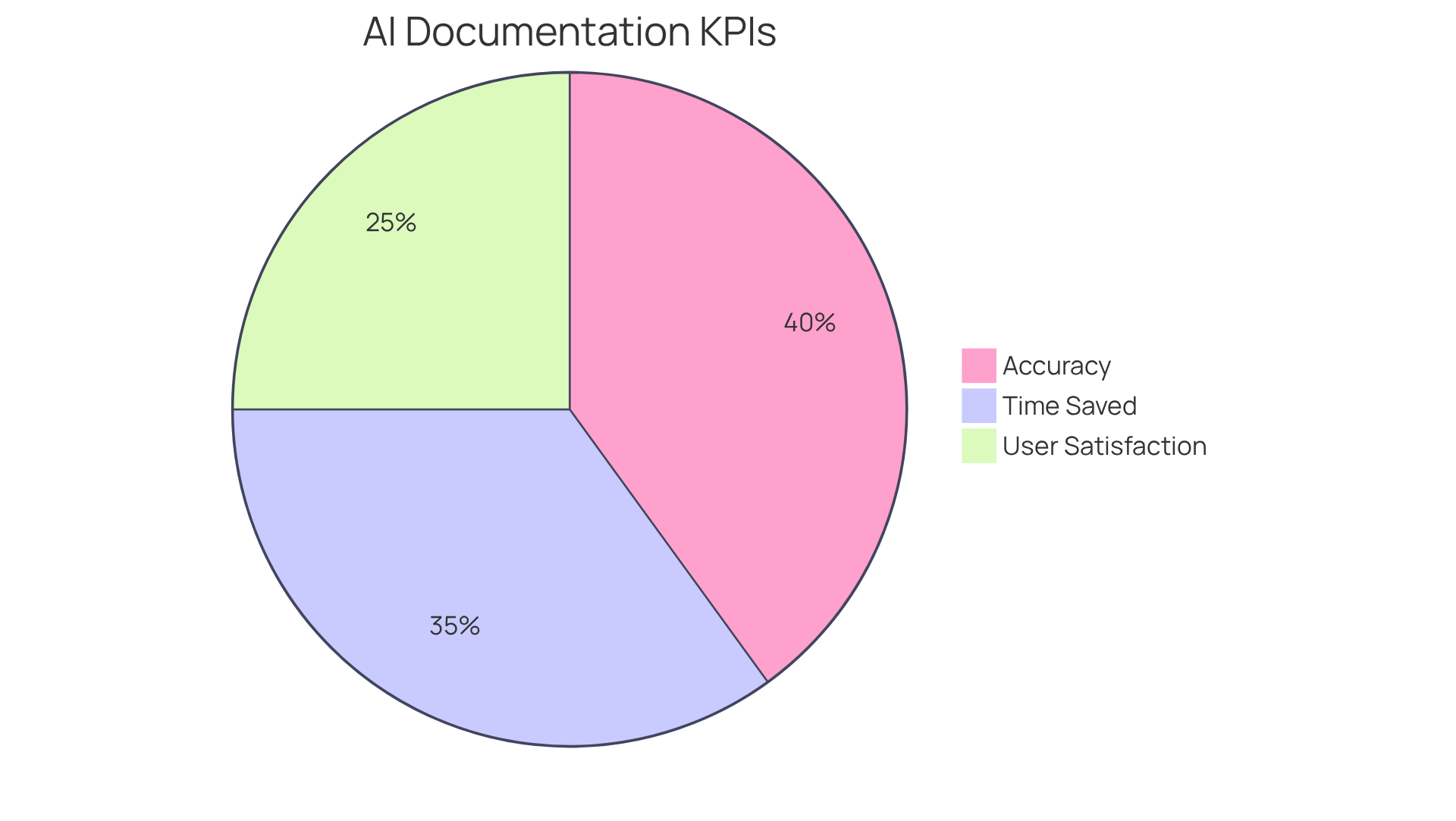
Automation and Documentation
|
October 16, 2025
|
4 Steps to Implement AI Documentation for Operations Managers
Overview
You might be wondering how to effectively implement AI documentation in your operations. Well, the article lays out four essential steps that can really help you out!
- First off, it’s all about selecting user-friendly tools that fit your needs.
- Then, integrating those tools into your existing workflows is key.
- Don’t forget to train your teams—this part is crucial!
- Finally, keeping an eye on performance will ensure everything runs smoothly.
Now, here’s the best part: these steps not only boost efficiency and compliance, but they also create a culture of adaptability. By embracing ongoing training and feedback, you’re setting the stage for improved operational outcomes. So, why not dive in and explore these solutions further? You’ve got this!
Key Highlights:
- AI automates repetitive documentation tasks, improving data accuracy and accessibility.
- Operations managers can streamline file creation, updating, and retrieval using AI tools.
- AI tools can identify gaps in existing documents and suggest improvements based on templates.
- Organisations adopting AI can enhance compliance by automatically updating records to meet regulatory standards.
- 42% of companies are piloting AI solutions, indicating a growing trend in AI adoption for documentation.
- Selecting user-friendly AI tools like Scribe and Mintlify is crucial for effective documentation.
- Integration of AI tools should include setting up APIs, staff training, and clear document management protocols.
- Training teams on AI documentation practises is essential for effective adoption and innovation.
- Hands-on experience with AI tools and ongoing training fosters a culture of adaptability and confidence.
- Monitoring KPIs such as document accuracy, time savings, and user satisfaction helps optimise AI documentation processes.
Introduction
As organizations increasingly embrace artificial intelligence, you might be wondering how this shift is changing the documentation game. For operations managers, tapping into AI tools is a fantastic chance to boost efficiency, accuracy, and compliance in record-keeping. But let’s be real—the road to effective AI documentation isn’t all smooth sailing. How can you ensure you’re picking the right tools, integrating them without a hitch, and training your team effectively? In this article, we’ll explore four essential steps to implement AI documentation, guiding you through the process of optimizing your documentation workflows and getting ready for the future of operational efficiency.
Understand the Role of AI in Documentation
You might be wondering how AI is shaking up the record-keeping game. Well, it's all about automating those repetitive tasks, boosting data accuracy, and making everything more accessible. For operations managers, understanding how AI documentation can streamline the processes of creating, updating, and retrieving files is a game changer. Imagine cutting down the time you spend on manual record-keeping!
Think about it: AI tools can dive into your current files, spot any gaps, suggest improvements, and even whip up new content using templates you set up. This means your records aren’t just thorough—they’re also flexible enough to adapt to your business's changing needs. And there’s more! AI is a key player in keeping you compliant by automatically updating records to meet regulatory changes, which helps you steer clear of risks tied to outdated information.
As more organizations jump on the AI bandwagon, it’s clear that the potential for boosting operational efficiency and accuracy is huge. So, it’s crucial for operations managers to leverage these advancements and utilize the AI documentation to make the most of what AI has to offer. Now, let’s dive into how you can start leveraging these tools for your own processes!

Select and Integrate AI Documentation Tools
You might be wondering how to effectively choose and incorporate resources for AI documentation. Well, operations managers should start by assessing their specific documentation needs and current workflows. Think about the types of files that could benefit from automation—like standard operating procedures (SOPs) or training manuals. Then, take a look at AI resources that shine in these areas. Focus on user-friendliness, integration capabilities, and customer support. Notable options like Scribe and Mintlify are great because they offer intuitive interfaces and robust features for document generation and management. Interestingly, 42% of companies are actively experimenting or piloting AI solutions, which shows that AI adoption is on the rise.
Now, once you’ve selected your tool, it’s time to plan the integration process. This might mean setting up APIs for smooth data transfer, training your staff on the new system, and establishing clear protocols for managing documents. A phased approach can really help minimize disruptions and allows you to make adjustments based on user feedback. As AI resources continue to evolve, staying updated on the latest trends in AI documentation will enhance both operational efficiency and scalability. In fact, a whopping 95% of companies using AI assistance report reduced costs and increased time savings, highlighting the real benefits of adopting these technologies. So, what are you waiting for? Let’s dive into making your documentation smarter!

Train Teams on AI Documentation Practices
You might be wondering why educating groups on AI record-keeping methods is so important. Well, it’s crucial for effective adoption! Start by organizing some workshops to introduce your team to the AI documentation and the resources you’ve chosen. Make sure to highlight their features and advantages in a way that feels relatable. For example, using real-world scenarios can really demonstrate how these resources can streamline AI documentation tasks, making everything more efficient. Did you know that studies show AI can cut manual grading time by 70%? That’s a huge boost in productivity!
To get everyone comfortable with the tools, consider assigning minor projects that require the use of AI tools. This hands-on experience will help your team members become familiar with the functionalities. And don’t forget to create a repository of resources—think video tutorials, user guides, and AI documentation—that employees can access whenever they need. It’s also a good idea to schedule regular follow-up sessions to tackle any challenges and share best practices.
As Michael Valderrama, a specialist in operations management, puts it, 'Ongoing training promotes a culture of innovation and flexibility within the group.' This continuous training approach not only builds confidence but also nurtures a culture of innovation and adaptability among your team. The result? Better quality records and improved operational efficiency!
Now, let’s talk about something that’s just as important: addressing concerns around data privacy and security. It’s essential that team members are aware of best practices in these areas. With 57% of people believing that AI in education will only increase in the future, committing to ongoing training and adaptation is key. So, what do you think? Are you ready to embrace the future of documentation?

Monitor and Optimize AI Documentation Processes
You might be wondering how to efficiently manage and improve your AI record-keeping processes. Well, a great starting point is setting up some key performance indicators (KPIs) to evaluate how well your AI resources are doing. Key metrics to keep an eye on include:
Regularly checking in on these metrics can help you spot areas that might need a little TLC.
For instance, if you find that document accuracy isn’t quite hitting the mark, it might be time to consider offering some extra training or tweaking the AI system's settings. And don’t forget about gathering feedback from your team! Their experiences with the AI tools can provide valuable insights into how user-friendly and functional those tools really are. By creating a continuous improvement cycle—where feedback leads to practical changes—you can keep your AI record-keeping processes efficient and ready to adapt to whatever business needs come your way.
So, what does effective KPI tracking look like in the context of AI documentation? Think about tracking:
- How much time is being saved on AI documentation tasks
- Measuring user satisfaction through quick surveys
- Checking the accuracy of generated documents against some established standards
It’s all about making sure your processes are not just efficient but also enjoyable for everyone involved!

Conclusion
Implementing AI documentation isn’t just a passing trend; it’s a game-changer for operations managers looking to boost efficiency and accuracy in their workflows. You might be wondering how AI can fit into your documentation process. By understanding its role, picking the right tools, training your teams effectively, and continuously fine-tuning your processes, you can tap into AI’s full potential to streamline operations.
So, what are the essential steps?
- Grasp AI's impact on documentation.
- Integrate the right tools.
- Train your teams for effective use.
- Keep an eye on performance through key metrics.
Each of these steps is vital to making AI documentation a core part of your operational strategy, which can lead to better productivity and lower costs.
But let’s be clear: embracing AI documentation goes beyond just keeping up with the latest technology. It’s really about nurturing a culture of innovation and adaptability within your teams. As you move forward, focusing on these strategies will not only improve your documentation practices but also set you up for long-term success in this digital age. So why wait? Taking action now can lead to some serious gains in operational efficiency and overall business outcomes.
Frequently Asked Questions
How is AI impacting documentation and record-keeping?
AI is automating repetitive tasks, boosting data accuracy, and enhancing accessibility in documentation and record-keeping.
What benefits do operations managers gain from AI documentation?
Operations managers can streamline the processes of creating, updating, and retrieving files, significantly reducing the time spent on manual record-keeping.
How does AI improve the quality of records?
AI tools can analyze existing files, identify gaps, suggest improvements, and generate new content using pre-set templates, ensuring records are thorough and adaptable to business needs.
In what way does AI help with compliance?
AI automatically updates records to align with regulatory changes, helping organizations avoid risks associated with outdated information.
Why is it important for organizations to adopt AI in documentation?
Adopting AI in documentation can significantly boost operational efficiency and accuracy, making it essential for organizations to leverage these advancements.
👍
What others are liking
5 Steps to outline your ideal documentation structure
5 MINS READ
Where to start the your journey of mapping out your ideal documentation structure, aligning it with the very heartbeat of your organization?
Defining a winning level of detail in your process
3 MINS READ
What is too much detail, and what is too little? This article described in that winning level detail about what detail is enough.





